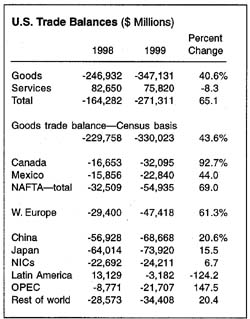February 18, 2000
NAFTA imports lead growth in U.S. trade deficit
The U.S. Department of Commerce today reported that the merchandise trade deficit rose 41% in 1999 to its highest level on record. The aggregate U.S. trade deficit in goods hit $347 billion in 1999, an increase of $100 billion over 1998. The deficit reflects rapid growth in imports from the NAFTA countries – Canada and Mexico – as well as China, Japan, and Western Europe. The U.S. trade balance with the rest of Latin America also deteriorated, while rising oil prices increased the deficit with OPEC, the oil producing countries. U.S. trade problems were compounded by a run-up in the value of the dollar, which has gained 16% in real value since 1995, and by slow or negative growth rates elsewhere in the world.
The broader goods and services deficit also increased in 1999 by 65% to $271 billion, another record high. U.S. goods and services imports jumped 12%, while exports increased less than 3% last year. U.S. imports grew nearly three times as rapidly as real GDP in 1999, as exporters from around the world targeted U.S. markets.
U.S. trade deficits with the NAFTA countries increased 69% in 1999. Imports from Canada, which were led by motor vehicles and parts, agricultural products, aircraft parts, and fuels, increased by $25 billion in 1999 alone. U.S. imports from Mexico, which increased by $15 billion in 1999, included motor  vehicles/parts and a wide array of electronic products, including televisions, computers, and telecommunications equipment, which were primarily assembled in the Maquiladora export-processing zones.
vehicles/parts and a wide array of electronic products, including televisions, computers, and telecommunications equipment, which were primarily assembled in the Maquiladora export-processing zones.
The U.S. deficits with China and Japan increased 21% and 16%, respectively, in 1999. These two countries were responsible for 43% of the total U.S. trade deficit in 1999. The U.S. trade deficit reflected a six-to-one ratio of imports to exports – the most imbalanced relationship in the history of U.S. trade. Japan has also maintained a persistent trade deficit with the United States for several decades.
U.S. imports from Western Europe, the rest of Latin America, and OPEC also grew rapidly last year. The trade deficit with Europe increased by 61% in 1999, as a result of rapid import growth. Imports from Latin America increased 16% in 1999, while exports to the region suffered a sharp 13% decline as a result of the financial crisis that spread from Brazil to many other countries in this region. Higher oil prices explain only a small share of the growth in the U.S. trade deficit, as the total bill for all petroleum imports, including those from OPEC, increased by only $16.5 billion.
The manufacturing sector lost 341,000 jobs in 1999. These losses continue a trend that began in March 1998. Job losses accelerated in 1999 because of the rapid growth of imports that competed with goods produced by U.S. manufacturing industries. Among industrial products, the trade deficit expanded most rapidly in 1999 in motor vehicles (an increase in the deficit of $25 billion), computers and office machines ($7.7 billion), televisions and VCRs ($7.6 billion), and aircraft ($4.3 billion). The trade balance improved most rapidly in iron and steel mill products, led by a decline of $4 billion in imports that resulted from the imposition of anti-dumping duties and other restrictions on steel products from a number of countries.
by Robert E. Scott
The Economic Policy Institute TRADE PICTURE is published upon the release of year-end trade figures from the Commerce Department.
